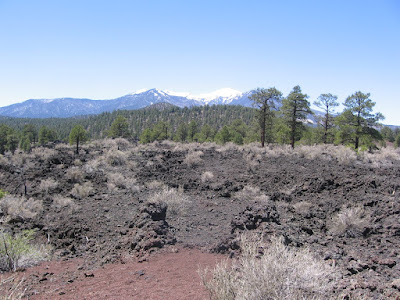The Wupatki Trail is 0.5 miles and visits the largest Ancestral Ruins site in Wupatki National Monument, near Flagstaff in northeast Arizona. Wupatki is in a unique location on the borders of several cultural traditions in the southwest and is also in one of the warmest and driest climates.
The Wupatki Trail begins at the Visitor Center and starts with a good overview of the site. There is a trail guide here with 20 stops and also interpretive signs in a few places. There are cinders in the area from the eruption of nearby Sunset Crater volcano. Wupatki was settled after the volcano eruption but it isn’t known if these two events are related. It is known that the volcanic ash retains moisture and may have helped with agriculture in an otherwise very dry area. Wupatki may have served as a trade area given its border location. The structure is three stories high in some places.
Like some other large sites in the region, the natural boulders form part of the structure. The stones used as bricks here are long and flat compared to the style used in the area close to Mesa Verde. I didn’t notice any dark basalt stones here as there are some of the other Wupatki National Monument sites.
North of the main structure there is a Great Kiva type structure. The interpretive information says that no evidence for a roof was found here and the typical floor features, like the ventilation system, of other Great Kivas are missing, so this may have been an open air community structure. In the colder climates, I usually think the kivas are best used for cold weather survival. Although it is warmer here than the higher elevation areas, there would still be some snow and cold here, and in the summers the sun would be too intense during most hours of the day without some sort of shade roof.
It does appear that there is a fire pit on the floor here. The bench area here is at a level that makes sitting practical. Sometimes, at other sites sitting on the bench is blocked by the low roof. Toward the end of the trail there is a smaller rectangular room that is described as a kiva.
The most unique structure at Wupatki is the structure that is described as the ball court. Ball courts are common at sites in southern Arizona and it appears to be an idea from cultures in Mexico. The court here is 78 feet wide and 102 feet long with a 6 foot high wall. It is something like a hockey rink.
Next to the ball court is a geologic feature called a blowhole. This is a crevice in the earth surface that appears to breathe based on changes in atmospheric pressure. During my visit the blowhole was inhaling. I set my trail guide over the screened hole and felt it get pulled to the screen as if by a strong exhaust fan.

The return leg of the trail passes an area where Park Rangers lived in the early years of the park. Apparently parts of the ruins were rebuilt, but then disassembled later. One of the rooms on the back side of Wupatki is formed largely from natural boulders and visitors are allowed to enter this room.


















